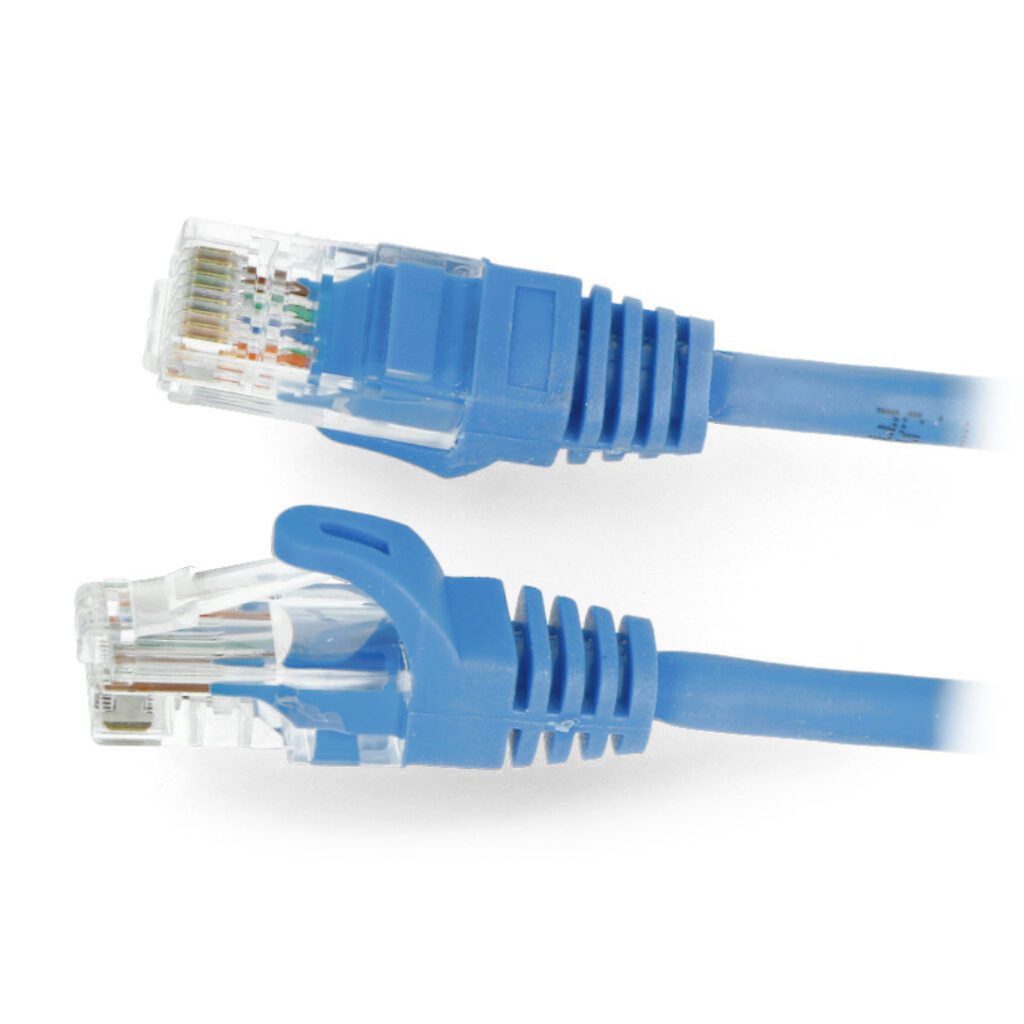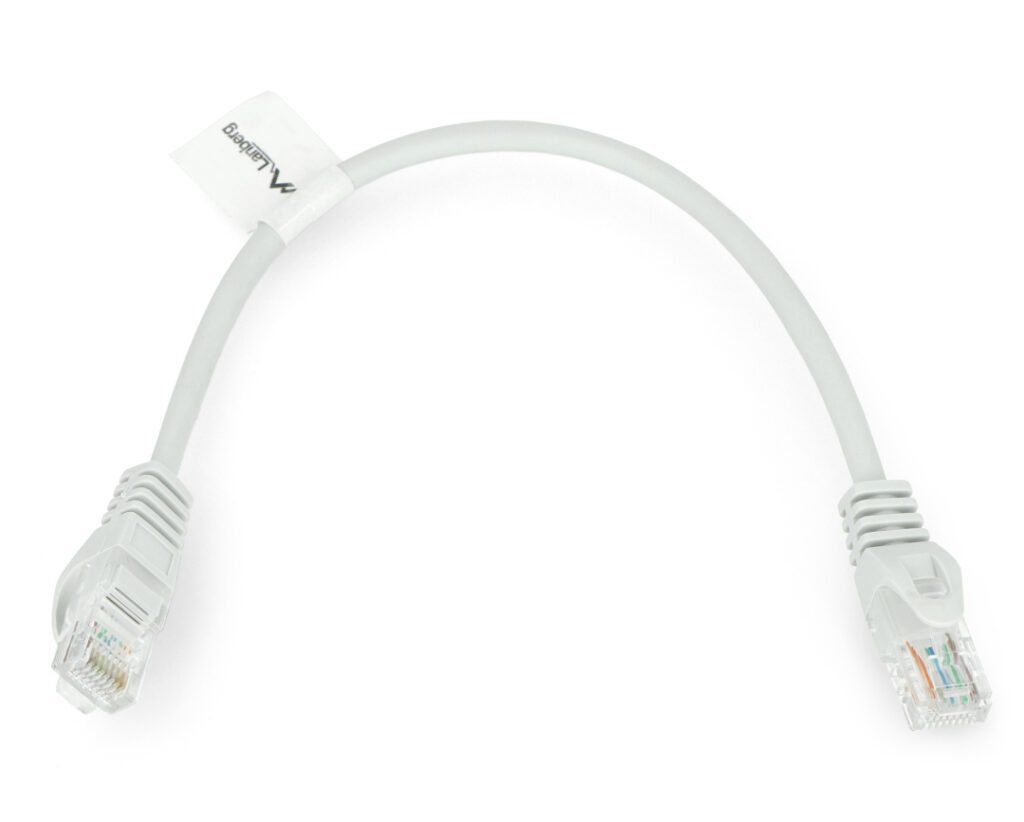Table of Contents:
Twisted-pair Internet cable, twisted-pair computer cable and Ethernet cable are cable terms designed for vertical and horizontal installations in data communications networks.
Internet twisted pair - what is it?
Twisted-pair cable is most commonly used for data transmission in both directions in computer networks. It finds application among others. In LANs (Local Area Networks). Some models of twisted-pair cables support PoE (Power over Ethernet) technology, which allows simultaneous transmission of data and power to connected devices using a single cable.
The term twisted pair comes from the method of manufacturing the cables, which involves the specific twisting of the individual conductors. The individual pairs of wires are twisted in such a way as to minimize the impact of external electromagnetic interference and interference from other pairs. Depending on the specific model, the twisted-pair cable can be equipped with an additional external shield and a screen to protect it from various types of interference. In addition, twisted-pair Internet cables can be divided by category.
FTP Internet twisted pair - what is it? Construction and additional information
Twisted-pair FTP computer cables (Foiled Twisted Pair) are a specific type of network cables that are designed to provide above-average protection against external electromagnetic interference. The abbreviation FTP means that the cable is equipped with a special sheath that entwines the twisted pairs of wires.
The twisted-pair Internet cable is built, among other things. Of copper wires (usually 8 twisted into 4 pairs). Another component is the shielding film, which acts as a screen to ensure stable operation under varying operating conditions. The cables of this type are also built with insulation that provides effective protection, among other things. Before short circuits. The outer cover, on the other hand, is made of plastic with different properties. It prevents mechanical damage. Twisted-pair FTP Internet cables are used in installations exposed to external electromagnetic interference.
UTP twisted pair cable - where is it used?
UTP Internet twisted pair (from Unshielded Twisted Pair) is a popular cable used in vertical and horizontal computer installations unaffected by electromagnetic interference. The popularity of UTP is due to its good price/performance ratio and transmission parameters. The construction of a twisted-pair cable includes 8 copper wires twisted into four pairs. All wires are equipped with insulation to prevent short circuits. On the other hand, an outer cover made of durable and flexible plastic protects against external factors. UTP twisted-pair cable is used in data communications networks to transmit data over short and medium distances.
Ethernet cable - types of outer sheaths and their properties
The outer coatings of twisted-pair cables protect the cables from mechanical damage and selected external factors (e.g., from exposure to high temperatures).
- The FRPVC (Fire Resistant Polyvinyl Chloride) coating is distinguished by its above-average fire resistance. In addition, during a fire it retards the spread of flames. In addition, the PVC material is resistant to oils and various chemicals.
- FRPVC STRONG coating is an additionally reinforced version of FRPVC coating that provides above-average resistance to mechanical damage.
- HDPE (High-Density Polyethylene) coating is made of a very high-density material. In practice, this means protection against moisture, chemicals and UV radiation. In addition, cables with this coating are relatively hard and durable.
- LDPE (Low-Density Polyethylene) coating is relatively softer and more flexible compared to HDPE plastic. In addition, it is distinguished by its resistance to oils, alcohols and selected acids.
- The LSOH (Low Smoke Zero Halogen) coating produces only a small amount of smoke when exposed to high temperatures. This plastic does not contain halogens, so it does not pose an additional risk during a fire. LSOH-coated twisted-pair Internet cable is used in particularly fire-prone areas.
- The LSOH/FRNC (Low Smoke Zero Halogen / Flame Retardant Non-Corrosive) coating is distinguished by the properties of FRNC, LSOH coatings and further retards the spread of flame during a fire. This type of coating does not produce corrosion during combustion.
- LSOH/LSHF/FRNC/LSZH coating (from Low Smoke Zero Halogen / Low Smoke Halogen Free / Flame Retardant Non-Corrosive / Low Smoke Zero Halogen). This plastic combines the properties of the previously mentioned materials. It ensures minimal smoke emissions during a fire, no halogens, no corrosion during combustion and delayed flame spread.
- LSZH (Low Smoke Zero Halogen) coating is distinguished by properties similar to LSZH and LSOH. It emits only a small amount of smoke when exposed to high temperatures. In addition, it does not contain halogens, so twisted-pair Internet cable with this coating is used in areas where the risk of fire is high.
Each of the above Internet cable outer sheaths has unique properties that make it suitable for a particular application. When selecting an Ethernet cable, special attention should be paid to the requirements of the project, as well as the conditions in which the cable will be used and the type of external factors.
Categories of twisted-pair cables
The various twisted-pair Internet cables also differ from each other by category, and more specifically by technical parameters (maximum data transfer speed and frequency of operation).
The higher the category, the higher the data transmission and frequency. There are categories 5e (Cat 5e), 6 (Cat 6), 6A (Cat 6A), 7 (Cat 7), 7A (Cat 7A), 8.1 (Cat 8.1) and 8.2 (Cat 8.2). Category 7 and higher twisted-pair Internet cable is used in server rooms, industrial applications and data centers.
The choice of a particular category depends not only on the project requirements, but also on the budget.
How useful was this post?
Click on a star to rate it!
Average rating 0 / 5. Vote count: 0
No votes so far! Be the first to rate this post.





















